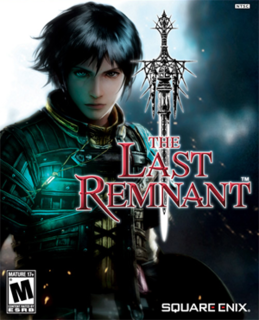A broken gem.
The Last Remnant is effectively rescued with the announcement of the New Xbox Experience. Downloading the game into the hard-drive mitigates, though not necessarily eliminates, the atrocious frame rate issue, a problem widely perceived as the developers' inability to operate the elusive Unreal Engine mechanics. It was the celebrated break for reviewers. After all, how good can a game be if it cannot even be run properly? Why bother?
Like a broken piece of a gem, The Last Remnant needs refinement, often at the interest of the players' personal artistry and judgment. It is an acquired taste, for the hardcore Japanese setting isn't easy to stomach, while the decidedly Western game play may alienate the staunchest of fans of the former. For the courted target crowd though, The Last Remnant offers plenty of intrigue, challenge and rewarding game play, which is something that cannot be said of the replicas of Role Playing Games that have littered the market since the genre gained its immense popularity. Having an open mind is essential to fully appreciate this unique blend of irreconcilable East-meet-West interchange.
The unmistakably Japanese setting first rear its ugly yet familiar head in its story. Rush Sykes, having his sister abducted, went on a rescue mission only to realise he is in the midst of a catastrophic event. As if conscientious about the "we know we need to save the world!" chants from the crowd, The Last Remnant became extremely restraint in its story-telling, instead allowing players to fill the gaps on what is the obvious themselves. Narratives, as a result, borderlines on being incoherent, a problem solved by the right amount of impressive cut-scenes (though let down by the technical incapability). The story of The Last Remnant is nothing to write home about, but ironic to its constraint manner of story-telling, it lingers long after one beats the game.
Game play is where this broken gem first flashes its shine. It forms an uncomfortable zone to the loyal RPG fans, for the each and every familiarity they spot, there seems to be an all-too-eager conflict to shatter any of such undue conceptions. Battles are effectively turn-based, but instead of controlling individual characters, they are arranged in unions commanded by collective directions. Dictated by the genre, players do grow in stature as the game progresses. But instead of 'levelling up' in the traditional sense, each unit improves its individual stats in a manner out of control of the helpless players. Yes, one also can customise and equip the characters with new items, but no, the game decides that one should not have complete control over doing so. It is this counter-intuitive game play, meshed with the complete lack of tutorials and directions that somehow allowed The Last Remnant to succeed in being both an incorrigible mess to some, yet impossibly endearing to others.
As if affection from the Japanese crowd is not sufficient, The Last Remnant charms the West with its comforting amount of constraint customisation and freedom. Unions can be built by recruiting individual characters of varied races and cIasses from the abundant side quests that players have the discretion of choosing. However, missing out on these side quests is akin to rejecting a huge chunk of what The Last Remnant has for offer. Most of them are designed with the intention of exposing players to the glorious large-scaled battles with minimal fuss. It does not matter that the quests themselves do not make much sense, for the satisfying game play is the only thing The Last Remnant preaches- everything else is really of no consequences.
The dramatic game play is easily matched by a fantastic selection of music. From the calmness of the peaceful towns to the pulsating turn-of-tides battles, each tune is extremely capable in amplifying the mood that the game seeks to create. While most of what construe The Last Remnant, such as game play and graphics, are subjected to personal tastes, the music and sound in this game is of no such contention- it is definitely one of the best that the genre has for offer.
The Last Remnant, if judged by the technicalities of what makes a game good or bad, definitely deserves no merit. Its awkwardness shouts for the need of a different set of lens for looking at, and for those who could do it; it is a gem, albeit broken, in the making. In times when the gap between heightened players' demand and the supply of RPGs that remains desperately formulaic is increasing, The Last Remnant's risky attempt in throwing something different into the mix should be congratulated, not met with disdain.

